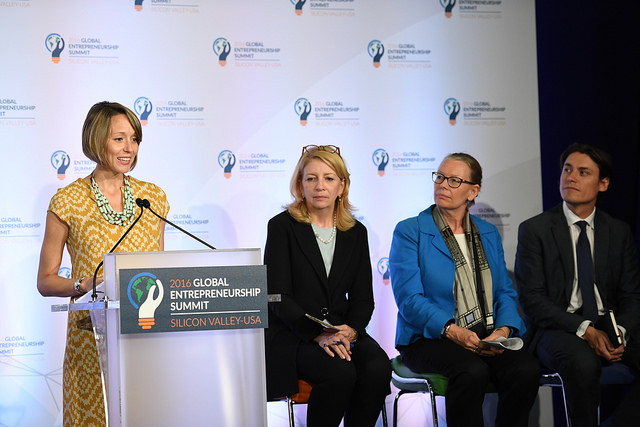Weekly Roundup is a McNair Center series compiling and summarizing the week’s most important Entrepreneurship and Innovation news.
Here is what you need to know about entrepreneurship this week:
Eliza Martin, Research Assistant, McNair Center for Entrepreneurship and Innovation
In 2016, Austin was ranked as the number one U.S. city for startup activity by the Kauffman Foundation. Austin’s entrepreneurial ecosystem began in the 1970s and 1980s, and was originally focused on computer and semiconductor manufacturing.
Austin’s “Silicon Hills” has diversified into “more than the computer chip and semiconductor industry that first enabled its growth.” The annual South by Southwest Festival draws thousands of tech startups to the city and provides excellent networking opportunities for entrepreneurs. The University of Texas at Austin adds thousands of skilled employees to the city’s labor force each year. Additionally, UT Austin’s boasts the Austin Technology Incubator, a startup-focused incubator run by the university’s IC2 Institute.
Austin provides entrepreneurs with supportive policy infrastructure, skilled and energetic laborers and access to valuable mentorship opportunities. If efforts to grow Austin’s economy continue on their current path, the city will be well poised to solidify its presence as a thriving entrepreneurial ecosystem.
Jeremy Quittner, Reporter, Fortune
Last week, a federal judge judge in Texas granted a preliminary injunction against the Department of Labor’s new overtime rules that were set to go into effect on December 1st. The new overtime rules would have increased the threshold salary for overtime workers to $47,476 from $23,600. Many small business owners, acting in preparation for the new rule, made the difficult financial decision to switch salaried workers to hourly status.
The preliminary injunction still must go through an additional 60 day period of court hearings before it becomes an official injunction. Additionally, the Obama administration’s Department of Labor could still appeal the judge’s decision to the U.S. Court of Appeals for the 5th circuit. It is not yet clear if the administration will challenge the judge’s decision. Even if the decision is appealed, success on appeal is doubtful; in the court’s recent history, the U.S. Court of Appeals for the 5th Circuit has tended to challenge the Obama administration.
McNair Center’s Catherine Kirby previously examined the effects of new overtime labor laws on small businesses in her blog post Small Business and Overtime Regulation.
Eugene Kim, Reporter, Business Insider
Peter Thiel, serial VC investor and founder of PayPal, is known for his profitable investments in successful billion dollar startups, such as Facebook, Palantir, Stripe and SoFi. Business Insider’s Kim reports possible insights into Thiel’s keen eye for return on investment.
In an interview at VC firm Khosla Ventures’ KV CEO Summit, Thiel recently said, “I think in some ways the really good companies often couldn’t even be articulated…we didn’t quite have the right words. Or maybe they were articulated but were articulated in terms of categories that were actually misleading.” Thiel cautioned investors away from startups that rely on buzzwords, such as big data or cloud computing, in their pitches. Thiel said, “…when you hear those words, you need to think fraud and run away as fast as you can. It’s like a tell that you’re bluffing, that there’s nothing unique about the business.”
Kate Conger, Reporter, TechCrunch
The White House recently announced “new and expanded plans to improve diversity and inclusion within the startup economy.” The plans are focused on promoting diversity in higher education, investment and entrepreneurship. The initiatives reflect the Obama Administration’s commitment to improving minority representation in universities, investment firms and tech companies. By focusing the initiatives within the private sector, these efforts will hopefully continue after his departure from office.
More than 200 universities, all members of The American Society for Engineering Education, have signed a pledge to promote diversity in their engineering programs. Additionally, more than 30 VC firms and accelerators signed a pledge to diversify access to seed and early stage capital for underrepresented entrepreneurs and reveal information regarding their portfolios’ diversity. Furthermore, 46 tech companies, including Xerox, have joined the Tech Inclusion Pledge, demonstrating a commitment to publicly publish recruitment goals and diversity metrics.
Tom Kalil, deputy director for technology and innovation at the White House Office of Science and Technology Policy, reportedly told TechCrunch there is existing data that indicates diverse firms are more diverse are more likely to be successful. According to Kalil, “A lot of innovation comes from diversity, people with different backgrounds.”
Ken Yeung, Contributor, VentureBeat
Civis Analytics recently announced that it bagged $22 million in its latest Series A funding round. Civis Analytics was born out of President Obama’s 2012 reelection campaign. Though originally focused on political campaigns, the data science company’s cloud-based platform provides data analytics tools and methodologies to organizations focused in areas such as health care, media and education. Since its inception, the startup has relied on revenues, rather than funding, to support its operations. However, the startup announced its recent funding will go toward hiring more engineers and data scientists.
Civis Analytics CEO, Dan Wagner states the importance of data analysis to business success: “Everyone knows that they need to be using data, but most don’t know where to start. Or, if they are using data, they aren’t necessarily asking and answering the right questions.”
Ryan Mac, Reporter, Forbes
Brothers Patrick and John Collison are cofounders of San Francisco-based startup Stripe. Stripe is a tech company that enables private individuals and companies to engage in transactions via the internet and on mobile apps. MIT and Harvard dropouts, respectively, Patrick and John Collison recently joined the ranks of the world’s youngest self-made billionaires. Stripe recently announced a successful funding round, which doubled the startup’s valuation to $9.2 billion. CapitalG and General Catalyst Partners jointly invested $150 million in Stripe during its latest funding round.
Despite their early success, the Collision brothers are still hungry for more; Patrick Collison told Forbes in January of 2014 that, “Heartening as the success to date has been, we are so early in accomplishing the goals that we set out for ourselves. If anyone here believes that Stripe has already made it, that would be hugely problematic for us.”
Ryan Pendell, Contributor, Silicon Prairie News
Victor Hwang, Vice President of Kauffman Foundation, and Phil Wickham, Executive Chairman of Kauffman Fellows set out on a road trip through America’s Midwest earlier this month to “take the pulse of entrepreneurship in America’s “middle.” Despite a nationwide political narrative that depicts the Midwest in a state of slumping stagnation, caught between booming coastal economies, Hwang and Wickham report that Midwestern entrepreneurs are actively seeking out business solutions to improve the quality of life within their communities. Since the benefits of the tech boom have been focused on the coasts, Hwang and Wickham cite the biggest challenges to Midwestern entrepreneurs as access to capital.
According to Hwang, the need to build infrastructure and capital should be considered both a challenge and an opportunity for Midwestern entrepreneurs going forward. Hwang expressed optimism for the future of the Midwestern economy, claiming that the region’s culture of “civic mindedness, that willingness to pitch in, that willingness to take risks and help others reach their ambitions” is still alive.
Ewing Marion Kauffman Foundation
According to a report recently published by the Kauffman Foundation, rethinking America’s “occupational licensing policy could counter recidivism, encourage entrepreneurship and boost the American economy.” Currently, occupational licensing requirements prevent individuals with a criminal history from securing licenses that could open the door to financial stability and self-sufficiency. Many occupations that require occupational licenses are on low-skilled and high-skilled professions; increased labor participation, productivity and entrepreneurship by released inmates within these fields could therefore produce benefits for the overall economy. According to the Kauffman Foundation’s study, over 60 percent of inmates released each year from state or federal prison are still unemployed after one year of their release.
The Kauffman Foundation’s Emily Fetsch notes that the high levels of recidivism and unemployment among ex-convicts indicate a fundamental issue with the country’s occupational licensing policy: “Hundreds of professions that require occupational licenses could provide paths to economic independence for those formerly incarcerated, except for the fact that their criminal histories alone may ban them from receiving licenses, even if their convictions had no relevancy to the job.”
Fetsch recommends reforms to occupational licensing policy that would exclude only criminal defendants who pose a a public threat or when convictions are recent and relevant to the context of an occupation. Additionally, Fetsch proposes offering the formerly incarcerated opportunities to earn rehabilitation or restoration certificates, thereby preventing inmates from automatic disqualification for consideration of occupational licenses solely on the basis of their arrest. Lastly, Fetsch contemplates disposing of occupational licensing requirements altogether, expressing skepticism for the regulation’s effects in promoting public safety and health.
Maura Ewing, Reporter, Bloomberg
“Amid calls for more job training, less automatic background searching and other changes that would make it easier for ex-felons to become employees” Bloomberg’s Ewing reports on an alternative perspective solution on the fight to curb recidivism and unemployment among the formerly incarcerated: encouraging them to start their own businesses.
The public and private sphere should continue to push programs that support formerly incarcerated individuals, as well as tackle the structural problems that face these prisoners as they re-enter society. However, Ewing asserts that more emphasis should be placed on the potential returns on fostering entrepreneurship among this commonly dismissed population.
Defy Ventures, a nonprofit incubator based in New York, certainly achieved success in this regard by transforming ex-convicts into entrepreneurs. Over the past six years, Defy Ventures has trained upwards of 500 released felons and successfully incubated over 150 companies. What’s more, the recidivism rate among the incubator’s alumni within five years post release is an astonishing 3 percent, compared to the national average of 76 percent. Defy Venture’s efficacy in curbing recidivism rates suggests that future initiatives to support released prisoners should be focused on entrepreneurship.
Ewing’s article tells the story of another incubator underway in Hartford. The incubator, TRAP House, focuses on supporting former drug dealers as they start new, legal companies. The incubator’s name makes a clever reference to slang for drug-stash locations and is “short for transforming, reinvesting and prospering.”
Happy Holidays from the McNair Center for Entrepreneurship and Innovation. The Entrepreneurship Weekly Roundup will return in January.





 Legislation passed during the first three months of the 115th Congress pays disproportionate attention to entrepreneurship and innovation. McNair Center research shows that in a typical congressional session, less than 2 percent of legislation introduced is relevant to E&I issues. As of March 23, three of the
Legislation passed during the first three months of the 115th Congress pays disproportionate attention to entrepreneurship and innovation. McNair Center research shows that in a typical congressional session, less than 2 percent of legislation introduced is relevant to E&I issues. As of March 23, three of the 









